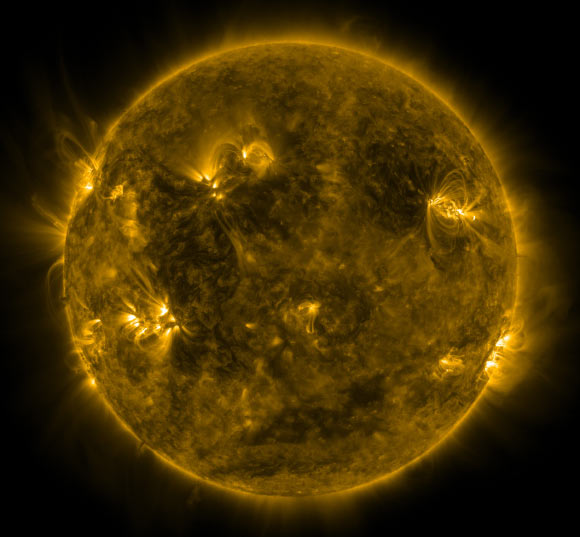Strong new evidence supports a theory that the Sun’s corona is heated by tiny explosions called nanoflares.

Dr Adrian Daw of NASA’s Goddard Space Flight Center and his colleagues have gathered some of the strongest evidence to date to explain what makes the Sun’s outer atmosphere so much hotter than its surface. Image credit: NASA / SDO.
The Sun’s visible surface, called the photosphere, is some 6,000 Kelvins, while the corona regularly reaches temperatures which are 300 times as hot.
For more than five decades, scientists have tried to figure out what causes the corona to be so hot. Every year or so, a press release appears purporting to solve the mystery, only to be shot down by a competing theory a year or so later. It is one of the most vexing problems in astrophysics.
Clear evidence now suggests that so-called nanoflares – a constant peppering of impulsive bursts of heating, none of which can be individually detected – provide the mysterious extra heat in the Sun’s corona.
“Nanoflares are impulsive heating bursts that individually reach incredibly hot temperatures of some 10 million Kelvins (18 million degrees Fahrenheit) – even greater than the average temperature of the corona – and provide heat to the atmosphere,” said Dr Jim Klimchuk of NASA’s Goddard Space Flight Center in Greenbelt, Maryland.
A billion times less energetic than ordinary solar flares, they have a power that belies their name. A typical nanoflare has the same energy as 240 megatons of TNT. That would be something like 10,000 atomic fission bombs.
“Millions of them are going off every second across the Sun, and collectively they heat the corona,” Dr Klimchuk said.
For one thing, nanoflares appear to be active throughout the solar cycle, which would explain why the corona remains hot during Solar Minimum. And while each individual nanoflare falls short of the energy required to heat the Sun’s atmosphere, collectively they might have no trouble doing to job.
The first evidence of nanoflares was found by the Extreme Ultraviolet Normal Incidence Spectrograph (EUNIS) sounding rocket mission in December 2013.
EUNIS flew on a 15-minute flight equipped with an instrument called a spectrograph, which can gather information about how much material is present at a given temperature. The instrument was tuned into a range of wavelengths useful for spotting material at temperatures of 18 million degrees Fahrenheit, the temperatures that signify nanoflares.
EUNIS’ spectrograph unambiguously spotted extremely hot material in active regions that visibly appeared to be quiet. In a quiet region, such hot temperatures clearly weren’t due to a large explosive solar flare, and so are a smoking gun that something otherwise unobservable was heating up this area.
The results were presented by Dr Adrian Daw of NASA’s Goddard Space Flight Center, EUNIS principal investigator, April 28 at the Triennial Earth-Sun Summit meeting in Indianapolis, IN.
_____







